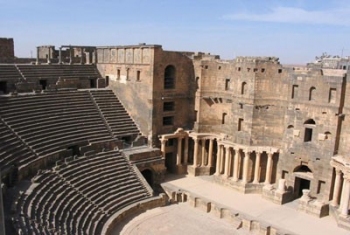
© Unknown
Syria, the land of civilizations and history, is rife with ancient monuments that tell the stories of the many peoples and civilizations that lived in it, whose stories endured in the face of time to tell humanity about their greatness.
"Beneath every footstep in Syria is an ancient civilization," says Archaeologist Markus Gschwind, head of the Syrian-German Archaeology Expedition working at al-Rafina in Hama. He notes that this saying is repeated around Germany, as most Germans consider Syria the most historically deep-rooted country in the Mediterranean.
In a statement to SANA, Gschwind said that he has been living and excavating in Syria for six years, each day discovering many secrets from the history of mankind.
He said that the expedition is currently undertaking surveying the ancient city of al-Rafina, which was one of the largest gathering points of Roman armies during the Roman era. Excavations in the area began in 2005 with the purpose of making an archeological map of the old city, detailing the various buildings, fortifications, streets, temples, camps and burial grounds, all of which are still buried beneath the earth.
Gschwind underlined the historic significance of al-Rafina, which was mentioned in ancient Roman texts as the birthplace of Roman emperor Elagabalus and other Roman emperors of Syrian descent, mainly the children of Julia Domna, emperors Geta and Caracalla.
Surveys in 2005 revealed the remains of pillars, burial grounds, walls and clay objects, with further surveys using ground-penetrating radar (GPR) serving to make an accurate map of the site, which will help facilitate and reduce the costs of future expeditions Gschwind said.
He went on to note that the ancient city is divided into two areas. The larger area was situated at the crossing of two ancient Roman roads, and included a circular Roman camp and a city surrounding it. The second area dates back to an older time period, with estimates suggesting that it was occupied before the Hellenistic period.
According to Gschwind, the city's strategic position in the center of Syria allowed it to be the headquarters of the Legio III Gallica, the largest group of Roman forces in the area and the first line of defense against the Persian Empire from the first to the third century AD.
One of the most important historic events in the city took place in 218 AD, when the soldiers of the Legio III Gallica elected Varius Avitus Bassianus, also known as Elagabalus, as emperor.
In the Byzantine era, a clerical headquarters affiliated to Apamea was established in the city, which all witnessed a war between the Byzantines and the Persians.
The people of the city where forced to abandon it during the first Crusade in 1098 AD, and later fell into the Crusaders' hands during the 12th century. King Fulk of Jerusalem was also surrounded by Muslim forces in the city, which fell under the rule of the Ayyubid dynasty and became part of Hama.
Gschwind concluded by noting that the distinguishing point between Syrian archeological sites and European ones is that the Romans used to build their cities in Syria on the ruins of older cities, as opposed to building new cities as they did in Europe, which is why ancient Syrian cities are so deep-rooted and date back to much older times that their European counterparts
Reader Comments
to our Newsletter